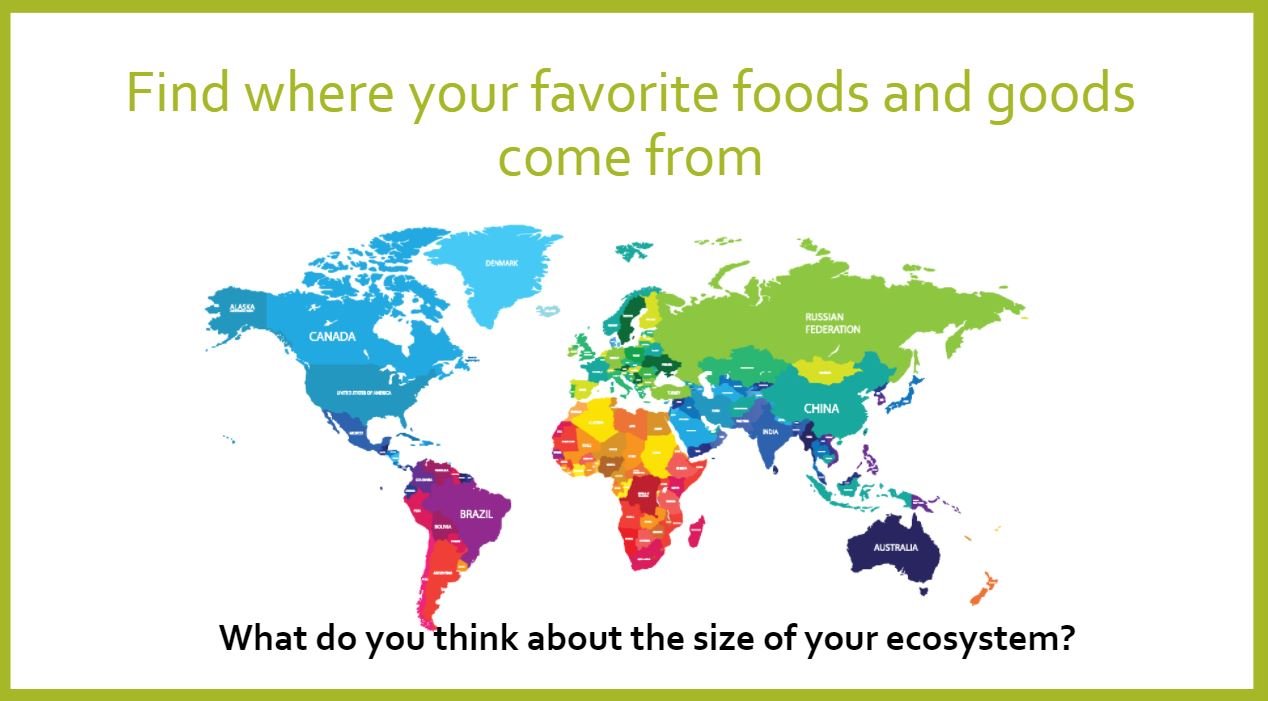How Large is My Ecosystem?
Time Duration
45-60 minutes
Purpose
Students will understand that the foods and natural resources they consume come from a broad ecosystem due to our farming, transportation, and commerce systems.
Kentucky Academic Standards
NGSS
3-LS2-1 Construct an argument that some animals form groups that help members survive.
MS-LS2-2 Construct an explanation that predicts patterns of interactions among organisms across multiple ecosystems.
Social Studies
5.G.GR.1 Use a variety of maps, satellite images and other models to explain the relationships between the location of places and regions and their human and environmental characteristics.
5.E.ST.1 Explain how specialization, comparative advantage and competition influence the production and exchange of goods and services in an interdependent economy.
Materials
Prepare
Show students the “How Large is My Ecosystem” portion of the digital presentation. Explain that humans were once dependent upon eating foods and using resources near their homes. They formed groups to help each other find food and combine resources for a better quality of life. When food or resources were depleted, they moved to a new location or faced hunger and a lesser quality of life.
Farming can provide a wealth of resources for humans. When more food or resources are produced than what is needed for the local community, they can sell them to nearby communities. Trade routes by land or water, and now by air, allow food and resources to be used from across the globe.
Procedures
Ask a student to volunteer what they have eaten this day. Write the list of items on the board.
Mark the items that could have come from a Kentucky farm. This list represents a relatively small local ecosystem.
Then ask where the other food items came. A list is provided, or you may have one or more students researching where some foods are commonly grown. Many processed food items have company or distributor information listed.
They may also look at the origins of their clothing and goods (this should be marked on most items).
Have students plot or color the origins of their food, clothing, and consumer goods on the world map. Then measure the distance between the farthest points on your map and research the distance in miles. This represents the size of the student’s ecosystem.
Discuss if large ecosystems are helpful or harmful to the human population and the environment. Guiding questions: What are the challenges and opportunities of having smaller and larger ecosystems? How does a large ecosystem benefit you? For example, if you depend on food that is only produced in your town, what happens if there is a drought? What are the fuel costs associated with food traveling from across the country or across the world? Does the quality of food suffer when it has to travel long distances? Does it make more sense to grow certain foods in a location with the perfect soil and climate, or would you change the soil and climate (greenhouse) to grow food much closer? What are the costs associated with doing this? What foods from other countries could you not live without?
Digging Deeper: Optional lesson for secondary students - Farm2School Lesson 1 Hometown City Exercise. See how buying locally affects the community.


